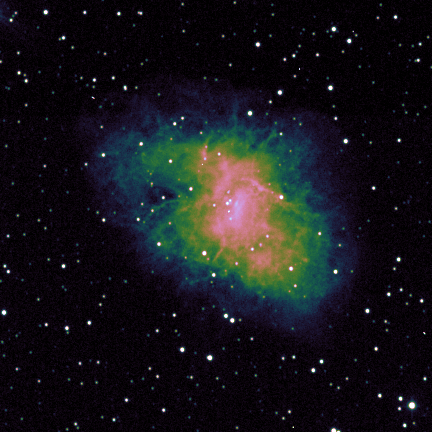About me
My name is Cameron Pfeffer and I am an Astronomy Ph.D. student at the Institute for Astronomy within the University of Hawaii: Mānoa. I am a member of Dr. Chris Ashall’s supernova research group, where I observe and model the most peculiar cosmic explosions. I am a National Science Foundation Graduate Research Fellow (NSF GRFP).
Socials:
Astronomical Observer
This is me, posing with the Swope telescope. Special thanks to the legendary astronomer Dr. Nidia Morrell for training me to use this amazing telescope
Using Swope, I took this 20 second g band exposure of Messier 1, the Crab Nebula. This object is one of the closest supernova remnants to earth, and it is one of my favorite astronomical objects to view. I was thrilled that I was able to take this image as a souvenir from my observing run on Swope.
I don’t just use telescopes, I model the data too! My first research project was modeling the photometric variability of the star α2 CVn. I used data from the Transiting Exoplanet Survey Satellite (TESS). Working with Dr. M. Virginia McSwain at Lehigh University, I wrote a model of this star’s dynamical magnetosphere in Python. In my model, particles trapped in the magnetosphere are responsible for its incredibly regular periodic variations in brightness. This research is published in the Astrophysical Journal.
After joining Chris Ashall’s lab, I pivoted to supernovae. I helped in the preparation of a publication focused on modeling the James Webb Space Telescope (JWST) data of the nearby Type Ia Supernovae SN2021aefx (pictured and circled on the right).
I am currently working on an abundance tomography model of a peculiar Calcium Strong Transient (CaST) called PTF09dav. This was a strange supernova. It was discovered dozens of kiloparsecs away from its host galaxy, and was much less luminous than normal Type Ia supernovae. After it aged and entered its nebular phase, it revealed strong [Ca II] lines and was classified as a CaST. This type of transient is poorly understood; astronomers disagree over the nature of the progenitors of this class. Perhaps by modeling the abundance stratification of different elements in its ejecta, some light can be shed on the origin of the mysterious and perplexing CaSTs. My publication on this research is currently in preparation.
I’ve been an astronomy enthusiast all my life. My passion for space began with long nights spent stargazing under the darkest skies in the east coast of the US— Ocracoke Island, North Carolina. When I got an Orion XT8 telescope in high school, I was certain that I would become an astronomer. Since then, I’ve worked my way up from that measly 8-inch reflector to some of the largest telescopes in the world. In 2023, I traveled to Chile to acquire photometry for young supernovae using the 1-meter Henrietta Swope Telescope at Las Campanas Observatory. Now I have the privilege to use the world class Mauna Kea telescopes on the big island of Hawaii. I’ve taken Near Infrared (NIR) spectra of supernovae with the Spex instrument on the 3.5-meter Infrared Telescope Facility (IRTF), and the NIRES instrument on the 10-meter Keck II observatory. I’ve also used the LRIS instrument Keck I to take optical spectra of supernovae.
Theoretical Astrophysicist
JWST image of SN 2021aefx and its host galaxy. Thank you to Judy Schmidt for this lovely visualization. This image is published in this paper, on which I am a co-author.
Papers
Peer Reviewed papers on which I am author or co-author:
Published
Submitted
JWST NIRSpec+MIRI Observations of the nearby Type IIP supernova 2022acko
The Hawaii Infrared Supernova Study (HISS): Spectroscopic Data Release 1
Non Peer Reviewed Papers - These are term papers I’ve written for classes. They serve as literature reviews for topics you may be interested in!



